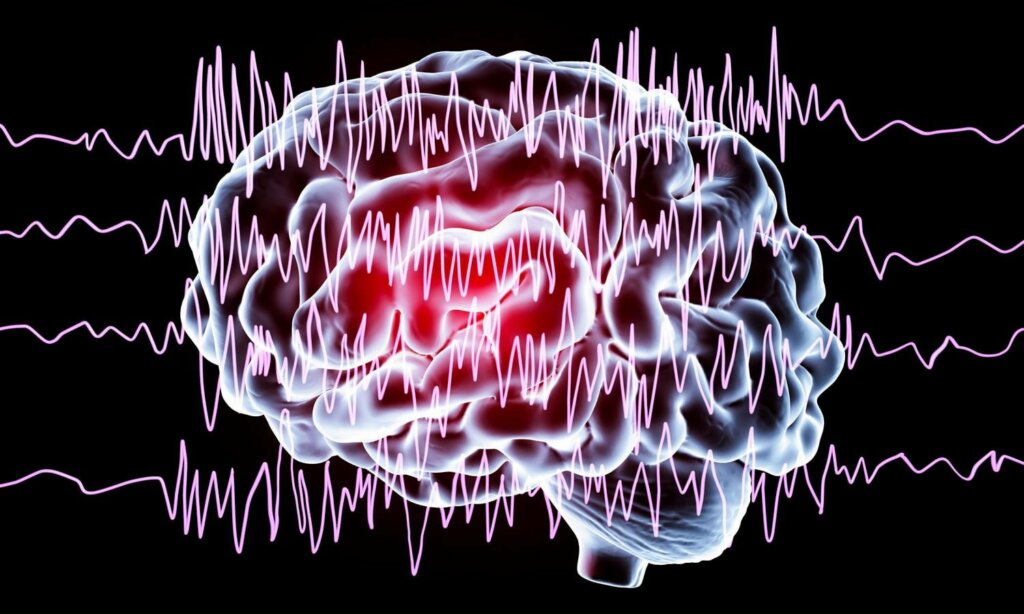Functional Neurologic Disorder (FND)


Reviewed and approved by the doctor Leonardo Biolatto
Sometimes, organic causes don’t explain certain conditions. Such is the case with functional neurologic disorder (FND). In fact, this condition alters the central nervous system for no specific neurological origin or cause.
This disorder presents a striking clinical picture. Moreover, a disabling one.
Here’s a simple explanation of functional neurologic disorder. A sufferer of multiple sclerosis knows that the source of the disorder is an autoimmune disease that affects the myelin in their brain and spinal cord. And, an individual who’s suffered a stroke knows that it’s due to a clogged or broken artery. However, some people suffer from speech and movement disorders without knowing what causes them. They don’t know what triggers the problem nor do they have a precise diagnosis. This is functional neurologic disorder.
These types of disorders are some of the most common reasons for medical consultations and neurological disability.

Functional neurologic disorder
Up until fairly recently, functional neurologic disorder was known as conversion disorder, as reported in the Revista Colombiana de Psiquiatría. Doctors, neurologists, psychiatrists, and all professionals in the clinical field know that this is a recurring problem in neurology and primary care services. However, the biggest problem lies in a proper diagnosis.
Research conducted by the CES University of Medellín (Colombia), highlights that the incidence of this disorder is 2.5 people per 100,000. It usually appears between 20 and 40 years of age. The most notable aspect of functional neurologic disorder is that the patients exhibit characteristics and symptoms of great impact. In addition, they have no clear origin.
Indeed, conventional tests, such as brain MRIs and EEGs, don’t reveal any problems and are generally normal. For this reason, for decades, the disorder has provoked great interest. Today, we know that it often overlaps with other problems like chronic pain and fatigue.
The symptoms of functional neurologic disorder
Until recently, it was assumed that functional neurologic disorder was purely psychological. In other words, scientists thought that patients also suffered from underlying mental problems. But, in the mid-2000s, neuroscientists confirmed that it’s a clinical reality with its own characteristics.
In fact, FND is a disorder of the functioning of the central nervous system. It varies greatly from one sufferer to another. A correct diagnosis is essential. The DSM-V (Diagnostic and Statistical Manual of Mental Disorders) has established the following criteria for its identification.
- Weakness of the lower or upper limbs.
- Functional tremor. These are tremors of the hands, similar to those of Parkinson’s disease.
- Dystonia. Contraction of the mouth on one side or deviation in the hands or feet.
- The appearance of non-epileptic seizures such as fainting.
- Sensory dysfunction. Numbness, tingling, or pain in the face, chest, hips, etc. These discomforts appear only on one side of the body. Alterations in vision, hearing, etc. also appear.
- Functional speech disorders. For example, problems articulating words, stuttering, hoarseness, etc.
To make a diagnosis, the DSM-V states that these symptoms can’t be explained by a neurological disease or condition or a mental health disorder.
The causes of FND
To this day, the exact causes behind functional neurologic disorder are unknown. However, it’s been observed that there are certain factors that increase the risk of it occurring. They’re as follows:
- Suffering from chronic pain.
- Having untreated post-traumatic stress disorder for several years.
- Having suffered from an infectious disease.
- Suffering from migraines.
- Having a history of neglect or sexual or physical abuse in childhood, etc.
This series of alterations has an impact on the central nervous system. In effect, they paralyze it and alter its proper functioning in certain areas. This explains the broad and diffuse symptoms of the disorder. Attention must also be paid to the impact it has on the sufferer. They suddenly experience problems in mobility or communication without really understanding why.
When they visit their primary care provider, they’re referred to neurology services. This is where they receive a diagnosis and intervention.

The treatment of functional neurologic disorder
Functional neurologic disorder is reversible. This means the symptoms end up disappearing by themselves over time. The mechanism used for treating this clinical condition is neuropsychological rehabilitation.
Treatment involves focusing on the sufferer’s abnormal and dysfunctional movement patterns and facilitating normal movement again via physiotherapy. Fortunately, there are no lesions or organic alterations in this disorder. In fact, it’s as if the brain (using the computer metaphor) has suffered a system failure and the failed program must be reinstalled.
In addition to physical or speech therapy, it’s advisable to also employ psychological therapy to address the particular needs of each patient. Such interventions ensure that these neurological alterations don’t reappear.
Sometimes, organic causes don’t explain certain conditions. Such is the case with functional neurologic disorder (FND). In fact, this condition alters the central nervous system for no specific neurological origin or cause.
This disorder presents a striking clinical picture. Moreover, a disabling one.
Here’s a simple explanation of functional neurologic disorder. A sufferer of multiple sclerosis knows that the source of the disorder is an autoimmune disease that affects the myelin in their brain and spinal cord. And, an individual who’s suffered a stroke knows that it’s due to a clogged or broken artery. However, some people suffer from speech and movement disorders without knowing what causes them. They don’t know what triggers the problem nor do they have a precise diagnosis. This is functional neurologic disorder.
These types of disorders are some of the most common reasons for medical consultations and neurological disability.

Functional neurologic disorder
Up until fairly recently, functional neurologic disorder was known as conversion disorder, as reported in the Revista Colombiana de Psiquiatría. Doctors, neurologists, psychiatrists, and all professionals in the clinical field know that this is a recurring problem in neurology and primary care services. However, the biggest problem lies in a proper diagnosis.
Research conducted by the CES University of Medellín (Colombia), highlights that the incidence of this disorder is 2.5 people per 100,000. It usually appears between 20 and 40 years of age. The most notable aspect of functional neurologic disorder is that the patients exhibit characteristics and symptoms of great impact. In addition, they have no clear origin.
Indeed, conventional tests, such as brain MRIs and EEGs, don’t reveal any problems and are generally normal. For this reason, for decades, the disorder has provoked great interest. Today, we know that it often overlaps with other problems like chronic pain and fatigue.
The symptoms of functional neurologic disorder
Until recently, it was assumed that functional neurologic disorder was purely psychological. In other words, scientists thought that patients also suffered from underlying mental problems. But, in the mid-2000s, neuroscientists confirmed that it’s a clinical reality with its own characteristics.
In fact, FND is a disorder of the functioning of the central nervous system. It varies greatly from one sufferer to another. A correct diagnosis is essential. The DSM-V (Diagnostic and Statistical Manual of Mental Disorders) has established the following criteria for its identification.
- Weakness of the lower or upper limbs.
- Functional tremor. These are tremors of the hands, similar to those of Parkinson’s disease.
- Dystonia. Contraction of the mouth on one side or deviation in the hands or feet.
- The appearance of non-epileptic seizures such as fainting.
- Sensory dysfunction. Numbness, tingling, or pain in the face, chest, hips, etc. These discomforts appear only on one side of the body. Alterations in vision, hearing, etc. also appear.
- Functional speech disorders. For example, problems articulating words, stuttering, hoarseness, etc.
To make a diagnosis, the DSM-V states that these symptoms can’t be explained by a neurological disease or condition or a mental health disorder.
The causes of FND
To this day, the exact causes behind functional neurologic disorder are unknown. However, it’s been observed that there are certain factors that increase the risk of it occurring. They’re as follows:
- Suffering from chronic pain.
- Having untreated post-traumatic stress disorder for several years.
- Having suffered from an infectious disease.
- Suffering from migraines.
- Having a history of neglect or sexual or physical abuse in childhood, etc.
This series of alterations has an impact on the central nervous system. In effect, they paralyze it and alter its proper functioning in certain areas. This explains the broad and diffuse symptoms of the disorder. Attention must also be paid to the impact it has on the sufferer. They suddenly experience problems in mobility or communication without really understanding why.
When they visit their primary care provider, they’re referred to neurology services. This is where they receive a diagnosis and intervention.

The treatment of functional neurologic disorder
Functional neurologic disorder is reversible. This means the symptoms end up disappearing by themselves over time. The mechanism used for treating this clinical condition is neuropsychological rehabilitation.
Treatment involves focusing on the sufferer’s abnormal and dysfunctional movement patterns and facilitating normal movement again via physiotherapy. Fortunately, there are no lesions or organic alterations in this disorder. In fact, it’s as if the brain (using the computer metaphor) has suffered a system failure and the failed program must be reinstalled.
In addition to physical or speech therapy, it’s advisable to also employ psychological therapy to address the particular needs of each patient. Such interventions ensure that these neurological alterations don’t reappear.
All cited sources were thoroughly reviewed by our team to ensure their quality, reliability, currency, and validity. The bibliography of this article was considered reliable and of academic or scientific accuracy.
- Aybek, S., & Vuilleumier, P. (2016). Imaging studies of functional neurologic disorders. Handbook of clinical neurology, 139, 73-84. https://www.sciencedirect.com/science/article/pii/B9780128017722000072
- Demartini, B., D’Agostino, A., & Gambini, O. (2016). From conversion disorder (DSM-IV-TR) to functional neurological symptom disorder (DSM-5): When a label changes the perspective for the neurologist, the psychiatrist and the patient. Journal of the Neurological Sciences, 360, 55-56. https://www.jns-journal.com/article/S0022-510X(15)30034-4/fulltext
- Espay, A. J., Aybek, S., Carson, A., Edwards, M. J., Goldstein, L. H., Hallett, M., … & Morgante, F. (2018). Current concepts in diagnosis and treatment of functional neurological disorders. JAMA neurology, 75(9), 1132-1141. https://jamanetwork.com/journals/jamaneurology/article-abstract/2682656
- Fobian, A. D., & Elliott, L. (2019). A review of functional neurological symptom disorder etiology and the integrated etiological summary model. Journal of Psychiatry and Neuroscience, 44(1), 8-18. https://www.jpn.ca/content/44/1/8.short
- Hallett, M., Aybek, S., Dworetzky, B. A., McWhirter, L., Staab, J. P., & Stone, J. (2022). Functional neurological disorder: new subtypes and shared mechanisms. The Lancet Neurology, 21(6), 537-550. https://www.thelancet.com/article/S1474-4422(21)00422-1/abstract
- Restrepo, M., & Restrepo, D. (2019). Del trastorno conversivo a los trastornos neurológicos funcionales.¿ Superando el diagnóstico por descarte?. Revista Colombiana de Psiquiatría, 48(3), 174-181. https://www.sciencedirect.com/science/article/pii/S0034745017301403
This text is provided for informational purposes only and does not replace consultation with a professional. If in doubt, consult your specialist.







